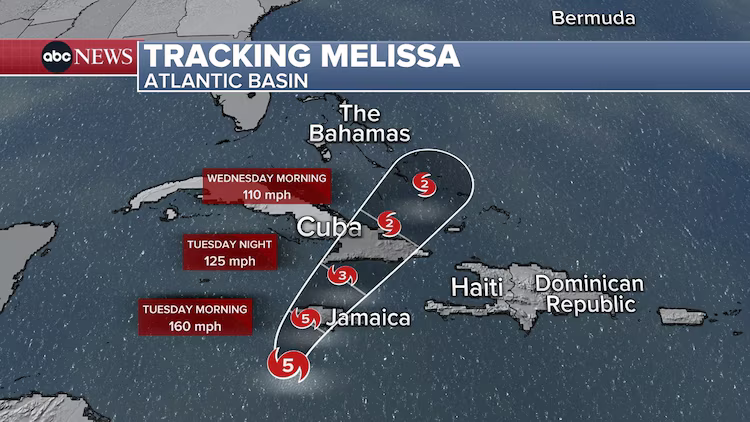Hurricane Melissa to Make Landfall in Jamaica

IN NEWS:
Hurricane Melissa to Make Landfall in Jamaica Today
Analysis
- Current Situation
- Hurricane Melissa has intensified into a Category 5 hurricane, the strongest storm of the year in the Caribbean region.
- The system is expected to make landfall in Jamaica by this evening, bringing catastrophic winds, life-threatening storm surges, and extreme rainfall.
- Wind speeds are currently reaching 175 miles per hour (≈280 km/h), with a movement of just 6 km/h, making the system unusually slow and highly destructive.
- Meteorological Concerns
- According to the U.S. National Hurricane Center (NHC), the hurricane’s slow west-north-west movement increases the risk of prolonged flooding and landslides.
- Rainfall up to 100 cm (≈40 inches) is expected in parts of Jamaica over the next four days.
- Experts describe Melissa’s movement as a “crawl,” which means it could linger over land and intensify the impact duration.
- Humanitarian Impact
- The storm has already claimed four lives in Haiti and the Dominican Republic, highlighting its destructive potential even before reaching Jamaica.
- Flood rescues are ongoing in these regions, with rising waters cutting off several communities.
- The Jamaican government has ordered mass evacuations in low-lying areas of Kingston and other coastal regions, classifying the entire island as threatened.
- Preparedness Measures
- Emergency shelters have been opened across Jamaica, and disaster management teams are on high alert.
- Ports and airports have been shut, and fishermen and coastal residents have been urged to move inland.
- The Caribbean Disaster Emergency Management Agency (CDEMA) and international relief organizations are coordinating with Jamaican authorities for rapid response and post-impact assessment.
- Regional Implications
- The storm’s trajectory could affect nearby islands and the southern coast of Cuba.
- Given its Category 5 intensity, global attention is on whether Melissa might become one of the most severe hurricanes in the Caribbean’s recent history.
- Economic disruptions are expected in tourism, agriculture, and logistics sectors due to infrastructural damage and power outages.
Static & Conceptual Background
- Hurricane Classification (Saffir–Simpson Scale)
- Category 1: 119–153 km/h (minimal damage)
- Category 2: 154–177 km/h (moderate damage)
- Category 3: 178–208 km/h (major damage)
- Category 4: 209–251 km/h (extreme damage)
- Category 5: ≥252 km/h (catastrophic damage)
- Formation and Movement
- Hurricanes form over warm ocean waters (typically >26°C) due to low-pressure systems and rising moist air, leading to cyclonic circulation.
- The Coriolis effect determines their rotation (counterclockwise in the Northern Hemisphere).
- A slow-moving system, like Melissa, tends to cause heavier rainfall and prolonged flooding due to extended exposure.
- Institutional Frameworks
- National Hurricane Center (NHC): U.S.-based agency under NOAA that monitors and forecasts tropical cyclones in the Atlantic and Eastern Pacific.
- CDEMA: Regional body coordinating disaster preparedness and response across the Caribbean.
- UNDRR and IFRC: Global partners supporting post-disaster resilience and recovery in small island developing states (SIDS).
Updated - October 28, 2025 8:27 AM | News On Air